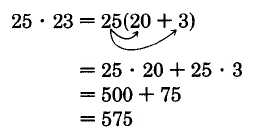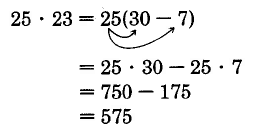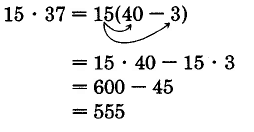8.3: Mental Arithmetic—Using the Distributive Property
- Page ID
- 48880
\( \newcommand{\vecs}[1]{\overset { \scriptstyle \rightharpoonup} {\mathbf{#1}} } \)
\( \newcommand{\vecd}[1]{\overset{-\!-\!\rightharpoonup}{\vphantom{a}\smash {#1}}} \)
\( \newcommand{\id}{\mathrm{id}}\) \( \newcommand{\Span}{\mathrm{span}}\)
( \newcommand{\kernel}{\mathrm{null}\,}\) \( \newcommand{\range}{\mathrm{range}\,}\)
\( \newcommand{\RealPart}{\mathrm{Re}}\) \( \newcommand{\ImaginaryPart}{\mathrm{Im}}\)
\( \newcommand{\Argument}{\mathrm{Arg}}\) \( \newcommand{\norm}[1]{\| #1 \|}\)
\( \newcommand{\inner}[2]{\langle #1, #2 \rangle}\)
\( \newcommand{\Span}{\mathrm{span}}\)
\( \newcommand{\id}{\mathrm{id}}\)
\( \newcommand{\Span}{\mathrm{span}}\)
\( \newcommand{\kernel}{\mathrm{null}\,}\)
\( \newcommand{\range}{\mathrm{range}\,}\)
\( \newcommand{\RealPart}{\mathrm{Re}}\)
\( \newcommand{\ImaginaryPart}{\mathrm{Im}}\)
\( \newcommand{\Argument}{\mathrm{Arg}}\)
\( \newcommand{\norm}[1]{\| #1 \|}\)
\( \newcommand{\inner}[2]{\langle #1, #2 \rangle}\)
\( \newcommand{\Span}{\mathrm{span}}\) \( \newcommand{\AA}{\unicode[.8,0]{x212B}}\)
\( \newcommand{\vectorA}[1]{\vec{#1}} % arrow\)
\( \newcommand{\vectorAt}[1]{\vec{\text{#1}}} % arrow\)
\( \newcommand{\vectorB}[1]{\overset { \scriptstyle \rightharpoonup} {\mathbf{#1}} } \)
\( \newcommand{\vectorC}[1]{\textbf{#1}} \)
\( \newcommand{\vectorD}[1]{\overrightarrow{#1}} \)
\( \newcommand{\vectorDt}[1]{\overrightarrow{\text{#1}}} \)
\( \newcommand{\vectE}[1]{\overset{-\!-\!\rightharpoonup}{\vphantom{a}\smash{\mathbf {#1}}}} \)
\( \newcommand{\vecs}[1]{\overset { \scriptstyle \rightharpoonup} {\mathbf{#1}} } \)
\( \newcommand{\vecd}[1]{\overset{-\!-\!\rightharpoonup}{\vphantom{a}\smash {#1}}} \)
Learning Objectives
- understand the distributive property
- be able to obtain the exact result of a multiplication using the distributive property
The Distributive Property
Distributive Property
The distributive property is a characteristic of numbers that involves both addition and multiplication. It is used often in algebra, and we can use it now to obtain exact results for a multiplication.
Suppose we wish to compute \(3(2 + 5)\). We can proceed in either of two ways, one way which is known to us already (the order of operations), and a new way (the distributive property).
Compute \(3(2 + 5)\) using the order of operations.
\(3(2 + 5)\)
Operate inside the parentheses first: \(2 + 5 = 7\).
\(3(2 + 5) = 3 \cdot 7\)
Now multiply 3 and 7.
\(3(2 + 5) = 3 \cdot 7 = 21\)
Thus, \(3(2 + 5) = 21\).
Compute \(3(2 + 5)\) using the distribution property.
We know that multiplication describes repeated addition. Thus,
\(\begin{array} {rclc} {3(2 + 5)} & = & {\underbrace{2 + 5 + 2 + 5 + 2 + 5}_{\text{2 + 5 appears 3 times}}} & {} \\ {} & = & {2 + 2 + 2 + 5 + 5 + 5} & {\text{(by the commutative property of addition)}} \\ {} & = & {3 \cdot 2 + 3 \cdot 5} & {\text{(since multiplication describes repeated addition)}} \\ {} & = & {6 + 15} & {} \\ {} & = & {21} & {} \end{array}\)
Thus, \(3(2 + 5) = 21\).
Let's look again at this use of the distributive property.
\(3(2 + 5) = \underbrace{2 + 5 + 2 + 5 + 2 + 5}_{2 + 5 appears 3 times}\)
\(3(2 + 5) = \underbrace{2 + 2 + 2}_{2 appears 3 times} + \underbrace{5 + 5 + 5}_{5 appears 3 times}\)

The 3 has been distributed to the 2 and 5.
This is the distributive property. We distribute the factor to each addend in the parentheses. The distributive property works for both sums and differences.
Sample Set A

Using the order of operations, we get
\(\begin{array} {rcl} {4(6 + 2)} & = & {4 \cdot 8} \\ {} & = & {32} \end{array}\)
Sample Set A

Using the order of operations, we get
\(\begin{array} {rcl} {8(9 + 6)} & = & {8 \cdot 15} \\ {} & = & {120} \end{array}\)
Sample Set A

Sample Set A

Practice Set A
Use the distributive property to compute each value.
\(6(8 + 4)\)
- Answer
-
\(6 \cdot 8 + 6 \cdot 4 = 48 + 24 = 72\)
Practice Set A
\(4(4 + 7)\)
- Answer
-
\(4 \cdot 4 + 4 \cdot 7 = 16 + 28 = 44\)
Practice Set A
\(8(2 + 9)\)
- Answer
-
\(8 \cdot 2 + 8 \cdot 9 = 16 + 72 = 88\)
Practice Set A
\(12(10 + 3)\)
- Answer
-
\(12 \cdot 10 + 12 \cdot 3 = 120 + 36 = 156\)
Practice Set A
\(6(11 - 3)\)
- Answer
-
\(6 \cdot 11 - 6 \cdot 3 = 66 - 18 = 48\)
Practice Set A
\(8(9 - 7)\)
- Answer
-
\(8 \cdot 9 - 8 \cdot 7 = 72 - 56 = 16\)
Practice Set A
\(15(30 - 8)\)
- Answer
-
\(15 \cdot 30 - 15 \cdot 8 = 450 - 120 = 330\)
Estimation Using the Distributive Property
We can use the distributive property to obtain exact results for products such as \(25 \cdot 23\). The distributive property works best for products when one of the factors ends in 0 or 5. We shall restrict our attention to only such products.
Sample Set B
Use the distributive property to compute each value.
\(25 \cdot 23\)
Solution
Notice that \(23 = 20 + 3\). We now write

Thus, \(25 \cdot 23 = 575\)
We could have proceeded by writing 23 as \(30 - 7\).

Sample Set B
\(15 \cdot 37\)
Solution
Notice that \(37 = 30 + 7\). We now write

Thus, \(15 \cdot 37 = 555\)
We could have proceeded by writing 37 as \(40 - 3\).

Sample Set B
\(15 \cdot 86\)
Solution
Notice that \(86 = 80 + 6\). We now write

We could have proceeded by writing 86 as \(90 - 4\).

Practice Set B
Use the distributive property to compute each value.
\(25 \cdot 12\)
- Answer
-
\(25(10 + 2) = 25 \cdot 10 + 25 \cdot 2 = 250 + 50 = 300\)
Practice Set B
\(35 \cdot 14\)
- Answer
-
\(35(10 + 4) = 35 \cdot 10 + 35 \cdot 4 = 350 + 140 = 490\)
Practice Set B
\(80 \cdot 58\)
- Answer
-
\(80(50 + 8) = 80 \cdot 50 + 80 \cdot 8 = 4,000 + 640 = 4,640\)
Practice Set B
\(65 \cdot 62\)
- Answer
-
\(65(60 + 2) = 65 \cdot 60 + 65 \cdot 2 = 3,900 + 130 = 4,030\)
Exercises
Use the distributive property to compute each product.
Exercise \(\PageIndex{1}\)
\(15 \cdot 13\)
- Answer
-
\(15 (10 + 3) = 150 + 45 = 195\)
Exercise \(\PageIndex{2}\)
\(15 \cdot 14\)
Exercise \(\PageIndex{3}\)
\(25 \cdot 11\)
- Answer
-
\(25 (10 + 1) = 250 + 25 = 275\)
Exercise \(\PageIndex{4}\)
\(25 \cdot 16\)
Exercise \(\PageIndex{5}\)
\(15 \cdot 16\)
- Answer
-
\(15 (20 - 4) = 300 - 60 = 240\)
Exercise \(\PageIndex{6}\)
\(35 \cdot 12\)
Exercise \(\PageIndex{7}\)
\(45 \cdot 83\)
- Answer
-
\(45 (80 + 3) = 3600 + 135 = 3735\)
Exercise \(\PageIndex{8}\)
\(45 \cdot 38\)
Exercise \(\PageIndex{9}\)
\(25 \cdot 38\)
- Answer
-
\(25 (40 - 2) = 1,000 - 50 = 950\)
Exercise \(\PageIndex{10}\)
\(25 \cdot 96\)
Exercise \(\PageIndex{11}\)
\(75 \cdot 14\)
- Answer
-
\(75 (10 + 4) = 750 + 300 = 1,050\)
Exercise \(\PageIndex{12}\)
\(85 \cdot 34\)
Exercise \(\PageIndex{13}\)
\(65 \cdot 26\)
- Answer
-
\(65 (20 + 6) = 1,300 + 390 = 1,690\) or \(65(30 - 4) = 1,950 - 260 = 1,690\)
Exercise \(\PageIndex{14}\)
\(55 \cdot 51\)
Exercise \(\PageIndex{15}\)
\(15 \cdot 107\)
- Answer
-
\(15 (100 + 7) = 1,500 + 105 = 1,605\)
Exercise \(\PageIndex{16}\)
\(25 \cdot 208\)
Exercise \(\PageIndex{17}\)
\(35 \cdot 402\)
- Answer
-
\(35 (400 + 2) = 14,000 + 70 = 14,070\)
Exercise \(\PageIndex{18}\)
\(85 \cdot 110\)
Exercise \(\PageIndex{19}\)
\(95 \cdot 12\)
- Answer
-
\(95 (10 + 2) = 950 + 190 = 1,140\)
Exercise \(\PageIndex{20}\)
\(65 \cdot 40\)
Exercise \(\PageIndex{21}\)
\(80 \cdot 32\)
- Answer
-
\(80 (30 + 2) = 2,400 + 160 = 2,560\)
Exercise \(\PageIndex{22}\)
\(30 \cdot 47\)
Exercise \(\PageIndex{23}\)
\(50 \cdot 63\)
- Answer
-
\(50 (60 + 3) = 3,000 + 150 = 3,150\)
Exercise \(\PageIndex{24}\)
\(90 \cdot 78\)
Exercise \(\PageIndex{25}\)
\(40 \cdot 89\)
- Answer
-
\(40 (90 - 1) = 3,600 - 40 = 3,560\)
Exercises for Review
Exercise \(\PageIndex{26}\)
Find the greatest common factor of 360 and 3,780.
Exercise \(\PageIndex{27}\)
Reduce \(\dfrac{594}{5,148}\) to lowest terms.
- Answer
-
\(\dfrac{3}{26}\)
Exercise \(\PageIndex{28}\)
\(1\dfrac{5}{9}\) of \(2 \dfrac{4}{7}\) is what number?
Exercise \(\PageIndex{29}\)
Solve the proportion: \(\dfrac{7}{15} = \dfrac{x}{90}\)
- Answer
-
\(x = 42\)
Exercise \(\PageIndex{30}\)
Use the clustering method to estimate the sum: \(88 + 106 + 91 + 114\).


